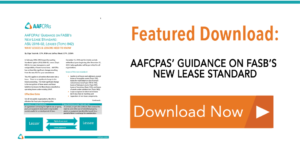Guidance on New Lease Accounting Standard
In 2016, FASB issued Accounting Standards Update (ASU) 2016-02, Leases (Topic 842) to increase transparency and comparability of lease transactions. AAFCPAs has summarized some of the most significant changes resulting from the new ASU for your convenience:
AAFCPAs has provided a detailed Whitepaper providing guidance on the FASB’s new Lease standard so clients may proactively consider the impact on their current and future operations. This Whitepaper outlines the significant changes resulting from the new ASU, including: a comprehensive outline of the scope of the new lease standard, effective dates, disclosure requirements, and practical considerations for lessees and lessors. Click here to download AAFCPAs’ Lease Accounting Whitepaper. >>
- Operating leases will now be recorded in the balance sheet as assets and liabilities if the lease term is greater than 12 months. Prior to this new standard, U.S. GAAP required only capital leases to be recognized on the balance sheet. This recognition of lease assets and lease liabilities by lessees for those leases classified as operating leases under existing GAAP is a very significant change to all reporting entities and will need significant analysis and evaluation.
- For leases with a term of 12 months or less, a lessee is permitted to make an accounting policy election not to recognize lease assets and lease liabilities, and recognize the lease expense generally on a straight-line basis over the lease term.
- The new standard makes a distinction between “operating leases” and “finance leases.” For operating leases, the lessees will recognize a “right-of-use” asset and a lease liability, initially at the present value of the lease payments, which represents the right to use the underlying asset during the term of the lease. The lease cost is calculated so that the cost of the lease is allocated over the lease term on a generally straight-line basis. For finance leases, the lessee will similarly record the right-of-use asset and a lease liability, again at the present value of the lease payments. However, interest on the lease liability is recognized separately from the amortization of the right-of-use asset. The cash payments related to operating leases are reflected in the operating section of the statements of cash flow. Cash payments related to the principal portion of a financing lease is classified in the financing activities, and payments of interest are reflected within operating activities of the statement of cash flows.
The lessor accounting is not significantly changing and will follow the new revenue standard.
This ASU applies to all entities that enter into a lease.
This change takes effect for fiscal years beginning after December 15, 2019, for non-public companies. Early application of the new lease standard is permitted for all entities.
What does AAFCPAs advise?
 In order to estimate how this change will affect your business, we recommend that you summarize all of your operating leases and consider the impact they will have on your financial statements. If the impact on your balance sheet is potentially significant, you may want to:
In order to estimate how this change will affect your business, we recommend that you summarize all of your operating leases and consider the impact they will have on your financial statements. If the impact on your balance sheet is potentially significant, you may want to:
- Calculate your loan covenant ratios using your balance sheet as adjusted for these accounting changes to make sure you are still in compliance.
- Amend existing loan agreements so the loan covenants exclude any impact from lease accounting rule changes.
- Modify or change existing loan covenant definitions and calculations to specifically exclude capital leases.
- Look at the impact of these changes to your expenses and the subsequent impact on any contracts, compensation agreements, etc.
- Consider if it still makes sense to lease instead of buying the asset.
- Estimate the effect of this change on the timing of your expenses and re-forecast your financial results to see the full impact of the change.
With respect to the transition to the new guidance, lessees and lessors are required to recognize and measure leases at the BEGINNING of the earliest period presented in the financial statements, using what is termed: a “modified retrospective approach.” The modified retrospective approach includes a number of optional practical expedients that entities may elect to apply. We recommend that you consult your AAFCPAs partner for further details.
If you have any additional questions about how the new Leases ASU will impact you, please contact Olga Yasinnik, CPA, MBA at oyasinnik@nullaafcpa.com, 774.512.4082; Jeffrey Mead, CPA, CGMA, Partner at 774.512.4143, jmead@nullaafcpa.com; or your AAFCPAs partner.


